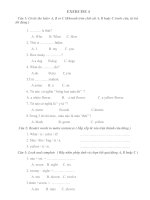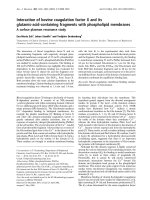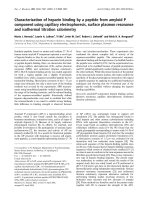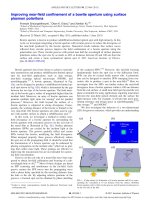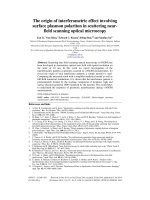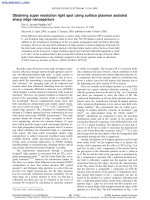Nanophotonics class 2 - surface plasmon polaritons
Bạn đang xem bản rút gọn của tài liệu. Xem và tải ngay bản đầy đủ của tài liệu tại đây (1.33 MB, 22 trang )
Nanophotonics
Class 2
Surface plasmon polaritons
Surface plasmon polariton: EM wave at metal-dielectric
interface
EM wave is coupled to the plasma oscillations of the surface charges
( )
( )
tzkxki
dd
zx
eEtzxE
ω
−+
=
0,
,,
( )
tzkxki
mm
zx
eEtzxE
ω
−−
=
0,
),,(
For propagating
bound waves:
- k
x
is real
- k
z
is imaginary
x
z
Derivation of surface plasmon dispersion relation: k(ω)
Wave equation:
Substituting SP wave + boundary conditions leads to the
Dispersion relation:
2/1
"'
+
=+=
dm
dm
xxx
c
ikkk
εε
εε
ω
2
,
2
,0,0,
2
t
E
E
md
mdmdmd
∂
∂
=∇
εεµµ
x-direction:
( )
ωε
=
ε
ω
c
k
Note: in regular dielectric:
λ
π
2
=
k
Dispersion relation:
2/1
"'
+
=+=
dm
dm
xxx
c
ikkk
εε
εε
ω
x-direction:
( )
ωε
Bound SP mode: k
z
imaginary: ε
m
+ ε
d
< 0, k
x
real: ε
m
< 0
so: ε
m
< -ε
d
2/1
2
,,,
"'
+
=+=
dm
m
mzmzmz
c
ikkk
εε
ε
ω
z-direction:
=
ε
ω
c
k
λ
π
2
=
k
( ) ( )
ωγω
ω
ωγωεεε
ε
iim
Ne
E
Nex
E
P
p
−
−=
−
−=+=+=
2
2
2
0
2
00
1111
0
2
ε
ω
m
Ne
p
=
Dielectric constant of metals
Drude model: conduction electrons with damping: equation of motion
with collision frequency
γ
and plasma frequency
If
γ
<<
ω
p
, then:
γ
ω
ω
ε
ω
ω
ε
3
2
2
2
",1'
pp
=−=
ti
eE
dt
dx
m
dt
xd
m
ω
γ
e
0
2
2
=+
no restoring force
Measured data and model for Ag:
γ
ω
ω
ε
ω
ω
ε
3
2
2
2
",1'
pp
=−=
γ
ω
ω
ε
ω
ω
εε
3
2
2
2
",'
pp
=−=
∞
Drude model:
Modified Drude model:
Contribution of
bound electrons
Ag:
45.5=
∞
ε
200 400 600 800 1000 1200 1400 1600 1800
-150
-100
-50
0
50
Measured data:
ε
'
ε
"
Drude model:
ε
'
ε
"
Modified Drude model:
ε
'
ε
"
ε
Wavelength (nm)
ε
'
Bound SP modes: ε
m
< -ε
d
200 400 600 800 1000 1200 1400 1600 1800
-150
-100
-50
0
50
Measured data:
ε
'
ε
"
Drude model:
ε
'
ε
"
Modified Drude model:
ε
'
ε
"
ε
Wavelength (nm)
ε
'
bound SP mode: ε
m
< -ε
d
-ε
d
ω
ω
p
d
p
ε
ω
+
1
Re k
x
real k
x
real k
z
imaginary k
x
real k
z
real k
x
imaginary k
z
d
x
ck
ε
Bound modes
Radiative modes
Quasi-bound modes
Surface plasmon dispersion relation:
Dielectric: ε
d
Metal: ε
m
= ε
m
'
+ ε
m
"
x
z
(ε'
m
> 0)
(−ε
d
< ε'
m
< 0)
(ε'
m
< −ε
d
)
2/1
+
=
dm
dm
x
c
k
εε
εεω
ω
Re k
x
d
x
ck
ε
Surface plasmons dispersion:
large k
small wavelength
Ar laser:
λ
vac
= 488 nm
λ
diel
= 387 nm
λ
SP
= 100 nm
Ag/SiO
2
3.4 eV
(360 nm)
X-ray wavelengths
at optical frequencies
2/1
+
=
dm
dm
x
c
k
εε
εεω
λ
π
2
=
k
Surface plasmon dispersion for thin films
Drude model
ε
1
(ω)=1-(ω
p
/ω)
2
Two modes appear
L
-
L
-
(symm)
Thinner film:
Shorter SP
wavelength
Example:
λ
HeNe
= 633 nm
λ
SP
= 60 nm
L
+
(asymm)
Propagation
lengths: cm !!!
(infrared)
Cylindrical metal waveguides
k
E
z
r
Fundamental
SPP mode
on cylinder:
E
•
Can this adiabatic coupling
scheme be realized in
practice?
taper theory first demonstrated by
Stockman, PRL 93, 137404 (2004)
Delivering light to the nanoscale
0.0 0.2 0.4 0.6 0.8 1.0
1.7
1.8
1.9
2.0
2.1
2.2
2.3
n
eff
= k
SPP
/k
0
Waveguide width (µm)
1 µm
1 µm
|E|
Field symmetry at tip
similar to SPP mode in
conical waveguide
E
+ +
+
+
+
+
+
Ewold Verhagen, Kobus Kuipers
k
E
x
z
nanoscale
confinement
Optics Express 16, 45 (2008)
Concentration of light in a plasmon taper: experiment
Ewold Verhagen, Kobus Kuipers
Au
Er
Al
2
O
3
λ = 1.5 μm
λ
exc
= 1490 nm
PL Intensity (counts/s)
10 µm
Ewold Verhagen, Kobus Kuipers
(1490 nm)
Er
3+
energy levels
transmission
1 µm
60 nm apex diam.
Nano Lett. 7, 334 (2007)
Concentration of light in a plasmon taper: experiment
550 nm
660 nm
•
Detecting upconversion luminescence from the air side of the film (excitation
of SPPs at substrate side)
Ewold Verhagen, Kobus Kuipers
Plasmonic hot-spot
Optics Express 16, 45 (2008)
k
E
x
z
Theory: Stockman, PRL 93, 137404 (2004)
Concentration of light in a plasmon taper: experiment
FDTD Simulation: nanofocussing to < 100 nm
z = -35 nm
•
Nanofocusing predicted: 100 x |E|
2
at 10 nm from tip
•
3D subwavelength confinement:
1.5 µm light focused to 92 nm (λ/16)
•
limited by taper apex (r=30 nm)
n
1
= 1
n
2
= 1.74
1 µm
1 µm
|E|
2
start
tip
+
+
+
+
++
+
E
Ewold Verhagen, Kobus Kuipers
Optics Express 16, 45 (2008)
sym asym
E
t
, H
Coaxial MIM plasmon waveguides
FIB milling of coaxial waveguides
100 nm
100 nm
•
Silica substrates with 250-500 nm thick Ag
•
Ring width: 50-100 nm
•
Two-step milling process
•
~7° taper angle
<w>=100 nm, L=485 nm
<w>=50 nm, L=485 nm
René de Waele, Stanley Burgos
Nano Lett. 9, in press (2009)
Narrow channels show negative index
•
Excitation above
resonance, ω>ω
sp
•
25 nm-wide channel
in Ag filled with GaP
•
Simulation shows
negative phase
velocity with respect
to power flow
•
Negative refractive
index of -2
René de Waele, Stanley Burgos
Positive and negative index modes
René de Waele, Stanley Burgos
Plasmonic toolbox: ω, ε(ω), d - Engineer λ(ω)
0 200 400 600 800 1000
-1.0
-0.5
0.0
0.5
1.0
Y Axis Title
Distance (nm)
thin section
Plasmonic concentrator
Plasmonic lens
Plasmonic multiplexer
And much more …
Plasmonic integrated circuits
Conclusions: surface plasmon polariton
Surface plasmon: bound EM wave at metal-dielectric interface
Dispersion: ω(k) diverges near the plasma resonance: large k, small λ
Control dispersion: control ω(k), losses, concentration
Manipulate light at length scales
below the diffraction limit
